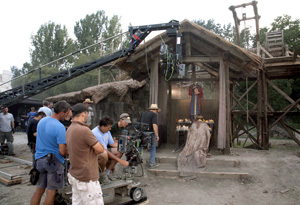Turning The Pillars of the Earth Book into a TV Movie

Photo: Egon Endrenyi
Author Ken Follett talks about the challenges of transitioning The Pillars of the Earth from book to television. Look for the movie that will air as a limited series on television in 2010.
First, an update on the television production of Pillars. As I write this, the television adaptation continues to move through the complex post-production process. The first four (out of eight) hours are almost "locked." Once locked, the picture editing is complete and will not change. Then the music, sound effects, visual effects and other remaining elements can be added—with painstaking precision and attention to detail.Also, there is exciting news to share. It was announced last week that Pillars will be broadcast in the United States, the biggest television market in the world, on Starz, under the Starz Original banner, in July. Due to their planned airdate, Starz will have the world television premiere of The Pillars of the Earth. I'll be sure to keep you posted on the U.S. development as we move closer to the airdates.
Now to address the challenges of translating a book to the screen. When Eye of the Needle was turned into a film almost 30 years ago, I was concerned by the need to compress several hundred pages into a couple of hours of screen time. Would I get letters from outraged readers, complaining that their favorite scene was missing? Would my favorite scene be cut?
I had the same worries about The Pillars of the Earth because I knew the limitations of a theatrical-length film. Even the usual four-hour TV adaptation couldn't do it justice. Too much would be lost because of "timing constraints." The eight hours of this Tandem production are another matter entirely. They do allow plot and characters to develop at an appropriate pace. The essence of the story is there, albeit not one to one.
Even with eight hours, choices had to be made about what would remain in the television adaptation and how best to tell the story in a visual medium.
Many hundreds of words of description are no longer required, because as the camera moves through the set, it shows what otherwise has to be read. The research behind those descriptive passages isn't lost, of course, it's there on the screen, in the sets, the props and costumes made with such care and attention in the Astra Studios workshops.
I needn't have worried because John Pielmeier has done a wonderful job with his screenplay. The screen writer's adaptation from a novel to a screenplay is clearly one of the most important aspects of the process. John had to make many decisions on how best to accomplish this. His ideas about how to compress the novel without losing its essence turned out very well on paper and are fantastic onscreen.
As you may recall from my first blog, I was amazed when I walked on set the first time and saw everything with my own eyes. The attention to detail was staggering. I was thrilled because my readers expect that degree of detail from me in my writing and historically accurate costumes, props and sets translate that detail onto the screen.
Director Sergio Mimica-Gezzan commented on the need for the cast and crew to educate themselves about the period in which the story takes place. That was essential in order for their work on the production to be properly informed and completely credible. I must say I was very impressed with the level of knowledge the key cast and crew had.
What fun it was to observe them all living and working in the 12th century!
Previous blog: Ken Follett on casting the villains in The Pillars of the Earth
Next blog: Ken Follett on writing the love stories of The Pillars of the Earth
Exclusive Videos



